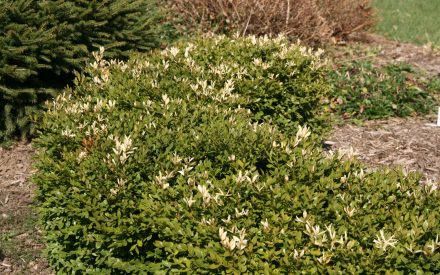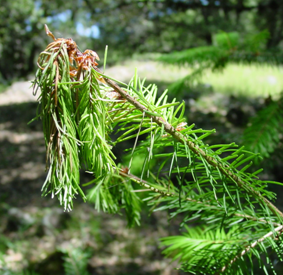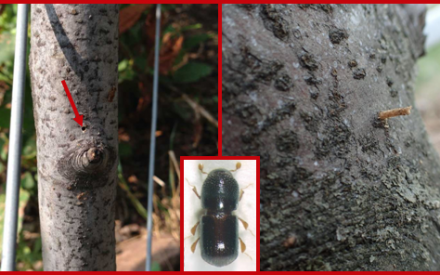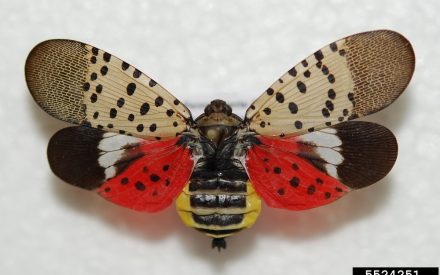
What is thousand cankers disease?
Thousand cankers disease (TCD) is a serious disease of black walnut (Juglans nigra), a tree native to Wisconsin. TCD has not yet been reported in Wisconsin, but has been found in the western United States where it was first described in 2008. TCD more recently has been reported in the eastern U.S. in Indiana, Maryland, North Carolina, Ohio, Pennsylvania, Tennessee, and Virginia. TCD has been fatal to black walnut in all known cases. Other walnut species found in the western U.S. [e.g., California walnut (Juglans californica) and Arizona walnut (Juglans major)] appear to be much less susceptible. Butternut (Juglans cinerea), another tree native to Wisconsin, is also known to be susceptible.
What does thousand cankers disease look like?
The first symptom of TCD is a yellowing of the leaves starting at the top of a walnut tree. Eventually lower leaves yellow and branches die. Death of the entire tree soon follows. Branches on trees with TCD have tiny holes (about the size of a pencil tip) made by a small beetle, the walnut twig beetle (Pityophthorus juglandis), that is involved in the disease. Beneath the bark of symptomatic branches, well-defined dark black or brown cankers (i.e., diseased areas) form. Cankers eventually merge, disrupting movement of water and nutrients in the tree, leading to tree death.
Where does thousand cankers disease come from?
Thousand cankers disease is caused by a combined effects of a fungus (Geosmithia morbida) and the walnut twig beetle. The insect carries the fungus on its body and introduces the fungus into a walnut tree as it tunnels into the bark to feed. Walnut twig beetles spread the fungus locally as they move from tree to tree to feed. The fungus does not appear to spread from tree to tree by root grafts. Longer distance dispersal of the insect and fungus is possible when walnut seedlings, walnut firewood, and walnut wood products are moved by human activities. Walnut fruits have not been reported as a source of the insect or fungus.
How can I save a tree with thousand cankers disease?
At this time, there are no formal recommendations for managing TCD. Researchers are attempting to develop treatment methods, including use of insecticides, fungicides and nutrient management, to help prolong the life of infected trees. Because TCD has not yet been reported in Wisconsin, the most important management strategy at this time is prevention.
How can I avoid problems with thousand cankers disease in the future?
The best way to prevent the spread of TCD (as well as other tree pests and diseases)s to not move firewood! For information about the restrictions on moving firewood in Wisconsin visit the Wisconsin Department of Natural Resources website. Also be cautious about moving walnut transplants or other walnut products (especially those with the bark still attached), particularly if they are coming from an area where TCD has been reported.
For more information on thousand cankers disease:
Contact the University of Wisconsin Plant Disease Diagnostics Clinic (PDDC) at (608) 262-2863 or pddc@wisc.edu.
Authors: Karen Schlichter*, UW-Madison Plant Pathology
Last Revised: 03/02/2024
D-number: D0113
*Completed as partial fulfillment of the requirements for Plant Pathology 558 at the University of Wisconsin Madison.
References to pesticide products in this publication are for your convenience and are not an endorsement or criticism of one product over similar products. You are responsible for using pesticides according to the manufacturer’s current label directions. Follow directions exactly to protect the environment and people from pesticide exposure. Failure to do so violates the law.
Thanks to Diana Alfuth, Cory Bender, Laura Jull, Phil Pellitteri, Katie Schlichter and Wendy Kramper for reviewing this document.
A complete inventory of UW Plant Disease Facts is available at the University of Wisconsin-Madison Plant Disease Diagnostics Clinic website: https://pddc.wisc.edu.
Send a Plant Sample for Analysis
Be cautious when self-diagnosing plant health issues. Very few diseases can accurately be diagnosed by eye.
Contact the UW Plant Disease Diagnostics Clinic (PDDC), and for a small fee, clinic staff can examine a plant, determine the cause of the disease/disorder, and provide advice on how to control or prevent the issue.
Download Article





 Boxwood Blight
Boxwood Blight Sudden Oak Death
Sudden Oak Death Black Stem Borer
Black Stem Borer Spotted Lanternfly
Spotted Lanternfly


